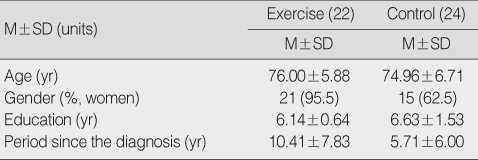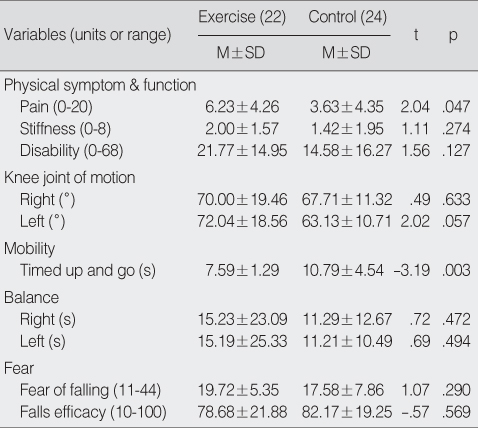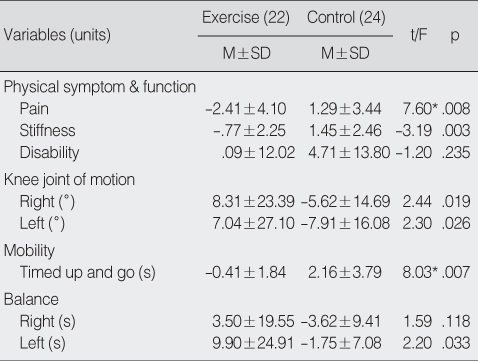Articles
- Page Path
- HOME > J Korean Acad Nurs > Volume 38(1); 2008 > Article
-
Original Article
- Effects of Tai Chi Exercise in Elderly with Knee Osteoarthritis
- Hea-Young Lee, Keum Jae Lee
-
Journal of Korean Academy of Nursing 2008;38(1):11-18.
DOI: https://doi.org/10.4040/jkan.2008.38.1.11
Published online: February 29, 2008
1Full-time Instructor, Department of Nursing, Kimcheon Science College, Gimcheon, Korea.
2Associate Professor, Department of Nursing, Kyungwon University, Seongnam, Korea.
- Address reprint requests to: Lee, Hea-Young. Department of Nursing, Kimcheon Science College, 480 Samrak-dong, Gimcheon, Korea. Tel: 82-54-420-9222, Fax: 82-54-420-9279, hylee@kcs.ac.kr
• Received: July 29, 2007 • Accepted: September 28, 2007
Copyright © 2008 Korean Society of Nursing Science
Abstract
-
Purpose
- This study was to determine whether the Sun-style 24 forms of Tai Chi exercise improve pain, stiffness, disability, knee joint motion, mobility, balance or falling.
-
Methods
- Forty-six community-dwelling elderly subjects (mean age, 75.46±6.28) voluntarily participated in an intervention group of either 24 forms of Sun-style Tai Chi for 60 min, 2 times per week for 12 weeks or a control group. A on-equivalent pretest-posttest design was used. Independent t-test and ANCOVA were used to examine group differences by using SPSS12.0.
-
Results
- The experimental group had significantly less pain (F=7.60, p=.008) and stiffness (t=-3.19, p=.003) than the control group. Also there were significant improvements in knee joint motion on the right knee (t=2.44, p=.019), left knee (t=2.30, p=.026), rising time (F=8.03, p=.07), balance on the left single leg test (t=2.20, p=.033), and fear of falling (t=-2.33, p=.024) in the Tai Chi exercise group. No significant group differences were found in disability and falls efficacy.
-
Conclusion
- The Sun-style 24 forms Tai Chi exercise is effective in decreasing pain, stiffness, fear of falling and it improves balance, rising time, and knee joint motion. We suggest a continuing long term intervention to decrease disability and increase efficacy concerning falls.
- 1. Allegrante JO, Kovar PA, Mackenzie CR, Peterson MGE, Gutin B. A walking education program for patients with osteoarthritis of the knee: theory and intervention strategies. Health Educ Q. 1993;20:63–81.ArticlePubMedPDF
- 2. Arnold CM, Faulkner RA. The history of falls and the association of the timed up and go test to falls and near-falls in older adults with hip osteoarthritis. BMC Geriatr. 2007;7:17. PubMedPMC
- 3. Bae SC, Lee HS, Yun HR, Kim TH, Yoo DH, Kim SY. Cross-cultural adaptation and validation of Korean Western Ontario and McMaster Universities (WOMAC) and Lequesne osteoarthritis indices for clinical research. Osteoarthritis Cartilage. 2001;9:746–750.ArticlePubMed
- 4. Bellamy N. Musculoskeletal clinical metrology. 1993;London, Kluwer Academic Publishers.
- 5. Bellamy N, Buchanan WW, Goldsmith CH, Campbell J, Stitt LW. Validation study of WOMAC: a health status instrument for measure clinically important patient relevant outcomes to antirheumatic drug therapy in patient with osteoarthritis of the hip or knee. J Rheumatol. 1988;15:1833–1840.PubMed
- 6. Campbell AJ, Robertson MC, Gardner MM, Norton RN, Buchner DM. Falls prevention over 2 years: A randomized controlled trial in women 80 years and older. Age Ageing. 1999;28:513–518.ArticlePubMed
- 7. Fuller GF. Falls in the elderly. Am Fam Physician. 2000;61:2159–2168.PubMed
- 8. Hoffman DF. Arthritis and exercise. Prim Care. 1993;20:895–910.ArticlePubMed
- 9. Jordan KM, Arden NK, Doherty M, Bannwarth B, Bijlsma JW, Dieppe P, et al. EULAR recommendations 2003: an evidence based approach to the management of kneeosteoarthritis: Report of a task force of the standing committee for international clinical studies including therapeutic trials (ESCISIT). Ann Rheum Dis. 2003;62:1145–1155.ArticlePubMedPMC
- 10. Korea Institute for Health and Social Affairs. 2005 national health and nutrition survey. 2006.
- 11. Lam P. New horizons. Developing tai chi for health care. Aust Fam Physician. 1998;27:100–101.PubMed
- 12. Lam P. How does Tai-Chi improve health and arthritis?. 2000;form http://www. taichiproductions.com.
- 13. Lee HY, Kim HI. Effects of sun style tai chi program on muscle strength and physical function in osteoarthritis patients. J Korean Nurses Association for Complementary Alternative Therapy. 2004;1:43–52.
- 14. Lee HY, Suh MJ, Lee EO, Eun Y, Choi JH. Analysis of the effectiveness of Tai Chi exercise for improving balance. J Korean Acad Adult Nurs. 2004;16:409–420.
- 15. Li F, Harmer P, Fisher KJ, McAuley E, Chaumeton N, Eckstrom E, et al. Tai Chi and fall reductions in older adults: a randomized controlled trial. J Gerontol A Biol Sci Med Sci. 2005;60:187–194.ArticlePubMed
- 16. Mathias S, Nayak USL, Isaacs B. Balance in the elderly patient: The "Get-up and Go" test. Physical Medicine Rehabilitation. 1986;67:587–591.
- 17. McAlindon TE, Wilson PW, Aliabadi P, Weissman B, Felson DT. Level of physical activity and the risk of radiographic and symptomatic knee osteoarthritis in the elderly: the Framinghamstudy. Am J Med. 1999;106:151–157.ArticlePubMed
- 18. McCarberg BH, Herr KA. American Academy of Pain Medicine. Osteoarthritis. How to manage pain and improve patient function. Geriatri. 2001;56:14–24.
- 19. Pandya NK, Draganich LF, Mauer A, Piotrowski GA, Pottenger L. Osteoarthritis of the knees increases the propensity to trip on an obstacle. Clin Orthop Relat Res. 2005;431:150–156.Article
- 20. Ross C, Bohannon S, Davis C, Gurchiek L. The effects of a short-term exercise program on movement, pain, and mood in the elderly. Results of a pilot study. J Holist Nurs. 1999;17:139–147.ArticlePubMedPDF
- 21. Schoenfelder DP. A fall prevention program for elderly individuals. Exercise in long-term care settings. J Gerontol Nurs. 2000;26:43–51.ArticlePubMed
- 22. Song RY, Lee EO, Lam P, Bae SC. Effects of Tai Chi exercise on pain, balance, muscle strength, and perceived difficulties in physical functioning in older women with osteoarthritis: A randomized clinical trial. J Rheumatol. 2003;30:2039–2044.PubMed
- 23. Taggart HM. Effects of Tai Chi exercise on balance, functional mobility, and fear of falling among older women. Appl Nurs Res. 2002;15:235–242.ArticlePubMed
- 24. Tideiksaar R. Falling in old age. Prevention and management. 1997;2nd ed.New York, Springer publishing Co..
- 25. Tinetti ME, Baker DI, McAvay G, Claus EB, Garrett P, Gottschalk M, et al. A multifactorial intervention to reduce the risk of falling among elderly people living in the community. N Engl J Med. 1994;331:821–827.ArticlePubMed
- 26. Tinetti ME, Speechley M. The effect of falls and fall injuries on functioning in community-dwelling older persons. J Gerontol. 1998;53:112–119.
- 27. Tinetti ME, Richman D, Powell L. Falls efficacy as a measure of fear of falling. J Gerontol. 1990;45:239–243.
- 28. van Baar ME, Dekker J, Lemmens JA, Oostendorp RA, Bijlsma JW. Pain and disability in patients with osteoarthritis of hip or knee: The relationship with articular, kinesiological, and psychological characteristics. J Rheumatol. 1998;25:125–133.PubMed
- 29. Wang TJ, Belza B, Thompson FE, Whitney JD, Bennett K. Effects of aquatic exercise on flexibility, strength and aerobic fitness in adults with osteoarthritis of the hip or knee. J Adv Nurs. 2006;57:141–152.Article
- 30. Wolf SL, Barnhart HX, Kutner NG, McNeely E, Coogler C, Xu T, et al. Reducing frailty and falls in older persons: an investigation of Tai Chi and computerized balance training. J Am Geriatr Soc. 1996;44:489–497.ArticlePubMed
REFERENCES
Figure & Data
REFERENCES
Citations
Citations to this article as recorded by 

- A Scoping Review of Interventions Aimed at Reducing Fear of Falling in Older Adults With Orthopedic Conditions
Sahar Johari, Joy MacDermid, Pulak Parikh, Ruby Grewal
Journal of Geriatric Physical Therapy.2025; 48(1): 42. CrossRef - The impact of community-based Tai Chi exercise on intrinsic capacity improvement in the elderly: a meta-analysis of randomized controlled trials
Yanzhi Lan, Jordan Tovera Salvador, Sa Zhang, Meng Wu
Postgraduate Medical Journal.2025;[Epub] CrossRef - Tai-Chi Exercise Training And Its Promising Therapeutic Impacts Among Older Community Dwelling Adults With Painful Knee Osteoarthritis
Ray Marks
Journal of Aging Research and Healthcare.2024; 5(1): 1. CrossRef - Bibliometric Analysis of Research on Traditional Chinese Exercise and Osteoarthritis
Qiu Zeng, Xiaoyi Liu, Lina Li, Qin Zhang, Chengping Luo, Shu Yang, Shuqiang Wu, An Yang, Jie Li
Journal of Pain Research.2024; Volume 17: 559. CrossRef - Effects of Taichi exercise on knee and ankle proprioception among individuals with knee osteoarthritis
Xiaoyue Hu, Zhangqi Lai, Lin Wang
Research in Sports Medicine.2020; 28(2): 268. CrossRef - Factors Affecting the Participation in Leisure Activities by Elderly Women Living Alone
Min Kyung Gu
Journal of Korean Academy of Community Health Nursing.2018; 29(3): 257. CrossRef - Influence of Leisure Activity Participation Between Genders Among Korean Older Adults
Min Kyung Gu, Sohyune R. Sok
Journal of Gerontological Nursing.2018; 44(11): 51. CrossRef - Effect of Tai-Chi on Grip Power, Pain and Fear of Falling in Elderly Person
Chung-uk Oh
Journal of the Korea Academia-Industrial cooperation Society.2016; 17(5): 631. CrossRef - Effects of Tai Chi on Balance and Muscle Activity of Ankle Joints with USN sensor in Elderly People
Jeong-Il Kang, Hye-Min Kwon
The Journal of the Korea institute of electronic communication sciences.2015; 10(3): 425. CrossRef - Relations among Fall Efficacy, Perception of Fall Risk and Fall Prevention Behavior in the Frail Elderly at Home
Young-Hee Kim
Journal of the Korea Academia-Industrial cooperation Society.2013; 14(7): 3383. CrossRef - Effects of Taekwondo Exercise Program in Women with Osteoarthritis
Young-Jae Kim, Nam-Sook Seo, Young-Nan Lim, Hyun-Sook Kim, Yun-Sung Kim, Sea-Ja Kim
Journal of muscle and joint health.2012; 19(2): 210. CrossRef - The Effects of an Aerobic Exercise Program on Mobility, Fall Efficacy, Balance, and Stress in the Elderly at Senior Centers
Su Kyung Chu, Chung Yul Lee, Jang Hak Yoo
Journal of Korean Academy of Community Health Nursing.2012; 23(1): 22. CrossRef - Complementary and Alternative Exercises for Management of Osteoarthritis
Ming-Chien Chyu, Vera von Bergen, Jean-Michel Brismée, Yan Zhang, James K. Yeh, Chwan-Li Shen
Arthritis.2011; 2011: 1. CrossRef - The Effects of a Case Management Program of Customized Home Visiting Health Service for Clients with Arthritis
Soon-Ok Yang, Myung Soon Kwon, Yong-Jun Choi, Seung-Hee Lee
Journal of Korean Academy of Community Health Nursing.2011; 22(2): 151. CrossRef - The Effects of a Tai Chi Exercise Program for Patients with Arthritis in Rural Areas
Aeyoung So, Kyung-Sook Lee, Jung Sook Choi, Eun Hee Lee
Journal of Korean Academy of Community Health Nursing.2010; 21(1): 118. CrossRef - Effects of Tai-Chi Exercise and Self-help Management Program Applying Laughter Therapy in Patients with Osteoarthritis
Keum-Soon Kim, Jeong-A Yu, Jin-A Kim, Yim-Sun Lee, In-Ok Lee
Journal of muscle and joint health.2010; 17(1): 68. CrossRef
Effects of Tai Chi Exercise in Elderly with Knee Osteoarthritis
Effects of Tai Chi Exercise in Elderly with Knee Osteoarthritis
Demographic Characteristics of Subjects
Homogeneity Test of the Outcome Variables
Mean differences of Physical function, Knee Joint of Motion, Mobility, and Balance between Pre-test and Post-test
*F value of ANCOVA.
Mean differences of Fear of Falling and Falls Efficacy between Pre-test and Post-test
Table 1
Demographic Characteristics of Subjects
Table 2
Homogeneity Test of the Outcome Variables
Table 3
Mean differences of Physical function, Knee Joint of Motion, Mobility, and Balance between Pre-test and Post-test
*F value of ANCOVA.
Table 4
Mean differences of Fear of Falling and Falls Efficacy between Pre-test and Post-test
 KSNS
KSNS
 E-SUBMISSION
E-SUBMISSION




 Cite
Cite

